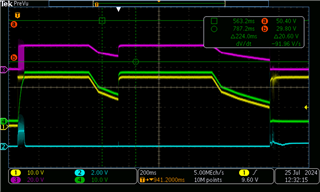Tool/software:
Hello,
In my schematic, I use the LMR51420 component to precharge my large 1000µF capacitors. My 24V input is switched abruptly by a mechanical switch. When my output voltage becomes close to the input voltage, I disable the LMR51420 and short my 24V in and 24V out with Q11.
The circuit works well on 30 boards, but I have 5 boards with the U4 component burned out. It burns out quickly during the first three startups. On the functional boards, I have tested with startups, even with a short circuit on the output, and with variations in the input voltage.
I don’t understand why, on some boards, the components burn out, while on others, it’s impossible to destroy them.
Do you have any ideas about this anomaly?





